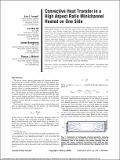| dc.contributor.author | Forrest, Eric C. | |
| dc.contributor.author | Buongiorno, Jacopo | |
| dc.contributor.author | Hu, Lin-Wen | |
| dc.contributor.author | McKrell, Thomas J. | |
| dc.date.accessioned | 2016-11-22T14:49:05Z | |
| dc.date.available | 2016-11-22T14:49:05Z | |
| dc.date.issued | 2015-10 | |
| dc.date.submitted | 2015-09 | |
| dc.identifier.issn | 0022-1481 | |
| dc.identifier.issn | 1528-8943 | |
| dc.identifier.uri | http://hdl.handle.net/1721.1/105395 | |
| dc.description.abstract | Experimental results are presented for single-phase heat transfer in a narrow rectangular minichannel heated on one side. The aspect ratio and gap thickness of the test channel were 29:1 and 1.96 mm, respectively. Friction pressure drop and Nusselt numbers are reported for the transition and fully turbulent flow regimes, with Prandtl numbers ranging from 2.2 to 5.4. Turbulent friction pressure drop for the high aspect ratio channel is well-correlated by the Blasius solution when a modified Reynolds number, based upon a laminar equivalent diameter, is utilized. The critical Reynolds number for the channel falls between 3500 and 4000, with Nusselt numbers in the transition regime being reasonably predicted by Gnielinski's correlation. The dependence of the heat transfer coefficient on the Prandtl number is larger than that predicted by circular tube correlations, and is likely a result of the asymmetric heating. The problem of asymmetric heating condition is approached theoretically using a boundary layer analysis with a two-region wall layer model, similar to that originally proposed by Prandtl. The analysis clarifies the influence of asymmetric heating on the Nusselt number and correctly predicts the experimentally observed trend with Prandtl number. A semi-analytic correlation is derived from the analysis that accounts for the effect of aspect ratio and asymmetric heating, and is shown to predict the experimental results of this study with a mean absolute error (MAE) of less than 5% for 4000 < Re < 70,000. | en_US |
| dc.description.sponsorship | United States. National Nuclear Security Administration. Global Threat Reduction Initiative (Argonne National Laboratory. Contract 25-30101-0004 A) | en_US |
| dc.description.sponsorship | United States. National Nuclear Security Administration. Office of Nonproliferation and International Security (Nuclear Nonproliferation Safeguards Graduate Fellowship) | en_US |
| dc.description.sponsorship | United States. National Nuclear Security Administration. (Sandia National Laboratories. Contract DE-AC04-94AL85000) | en_US |
| dc.language.iso | en_US | |
| dc.publisher | ASME International | en_US |
| dc.relation.isversionof | http://dx.doi.org/10.1115/1.4031646 | en_US |
| dc.rights | Article is made available in accordance with the publisher's policy and may be subject to US copyright law. Please refer to the publisher's site for terms of use. | en_US |
| dc.source | ASME | en_US |
| dc.title | Convective Heat Transfer in a High Aspect Ratio Minichannel Heated on One Side | en_US |
| dc.type | Article | en_US |
| dc.identifier.citation | Forrest, Eric C. et al. “Convective Heat Transfer in a High Aspect Ratio Minichannel Heated on One Side.” Journal of Heat Transfer 138.2 (2015): 21704. © 2016 by ASME | en_US |
| dc.contributor.department | Massachusetts Institute of Technology. Department of Nuclear Science and Engineering | en_US |
| dc.contributor.department | MIT Nuclear Reactor Laboratory | en_US |
| dc.contributor.mitauthor | Hu, Lin-Wen | |
| dc.contributor.mitauthor | McKrell, Thomas J | |
| dc.relation.journal | Journal of Heat Transfer | en_US |
| dc.eprint.version | Final published version | en_US |
| dc.type.uri | http://purl.org/eprint/type/JournalArticle | en_US |
| eprint.status | http://purl.org/eprint/status/PeerReviewed | en_US |
| dspace.orderedauthors | Forrest, Eric C.; Hu, Lin-Wen; Buongiorno, Jacopo; McKrell, Thomas J. | en_US |
| dspace.embargo.terms | N | en_US |
| mit.license | PUBLISHER_POLICY | en_US |
